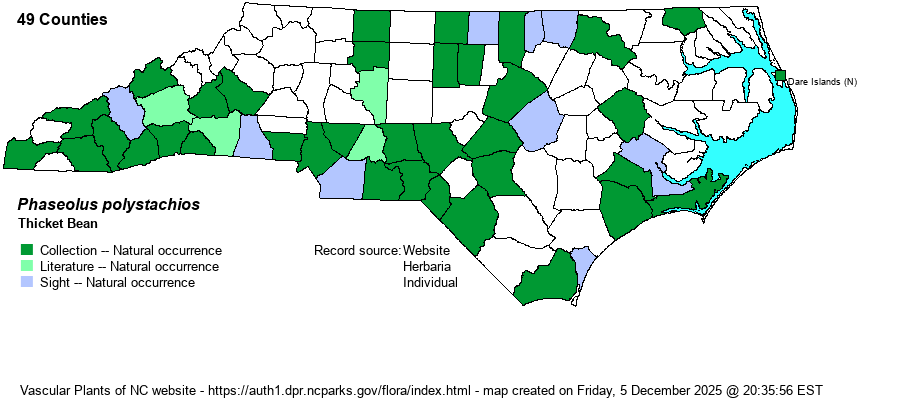| Author | (L.) Britton, Sterns, & Poggenburg | |
| Distribution | Scattered over the entire state, though more often found in the southern half of the Mountains and the eastern two-thirds of the Piedmont. However, it has been found in five coastal counties, and thus in theory it could be found in nearly all of the state's counties.
This is a wide-ranging yet not common species occurring from CT, NY, and MO south to southern FL and eastern TX.
| |
| Abundance | Uncommon over the state, as a whole; can be at least locally fairly common in the southern Mountains, but certainly not often found in the rest of the state. Rare in much of the eastern Coastal Plain and seemingly the northwestern portion of the state. The NCNHP State Rank of S3 seems somewhat conservative, considering records from at least 49 counties over all parts of the state. Weakley (2018) states that it is "seemingly declining", which might be true. Also, populations often contain few individuals. | |
| Habitat | This is a species of rich to mesic hardwood forests and their edges, including moist thickets as well as on rocky slopes. It favors high pH soils and certainly does not occur in pine stands or strongly acidic soils. |
| Phenology | Blooms from July to September, and fruits from August to October. | |
| Identification | This is a trailing or weakly climbing "vine", often to 2 feet long. As it often occurs along wooded borders and openings, it can occur in dense patches such that it is difficult to see an individual plant. It looks quite similar to American Hog-peanut (Amphicarpaea bracteata), which grows in the same habitats but is much more common and often seen. It also looks like a small version of the exotic pest Kudzu (Pueraria montana). Phaseolus has trifoliate leaves, with the terminal leaflet being ovate to nearly triangular, with a pointed tip (often acuminate), about 3 inches long and nearly as wide. The two lateral leaflets are smaller and have asymmetrical bases, easily seen by the vein pattern; these leaflets are about 2 inches long and about 1 inch wide, ovate and slightly acuminate at the tip. The leaflets may be glabrous above, but beneath are quite pubescent and have uncinate (hooked) hairs, so that you can pick a leaflet and attach the lower side to your clothing! The other two species do not have hooked hairs below. In addition, the inflorescences are quite different. This species has loose racemes of bright rose-pink flowers, on a stalk of 4-5 inches long. Each flower is about 1/2-inch long and shows two rounded petals at the bottom of the flower. American Hog-peanut has flowers in dense clumps, and they are white or very pale pink; whereas Kudzu has large purple flowers. This is a species that can be a good indicator of high pH soil, with other rare to uncommon plants in the vicinity. | |
| Taxonomic Comments | A number of references include P. sinuatus within P. polystachios, as a variety. This is highly disturbing, and to experienced biologists who know both of these entities well, simply just incorrect.
| |
| Other Common Name(s) | This species has never had a good and frequently used common name, and the use of "Wild Bean" is simply too generic. Wild Kidney Bean is another name. | |
| State Rank | S3 [S4] | |
| Global Rank | G5 | |
| State Status | | |
| US Status | | |
| USACE-agcp | | |
| USACE-emp | | |

